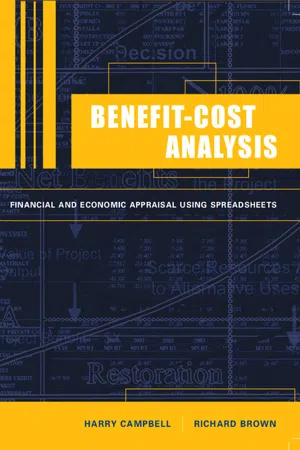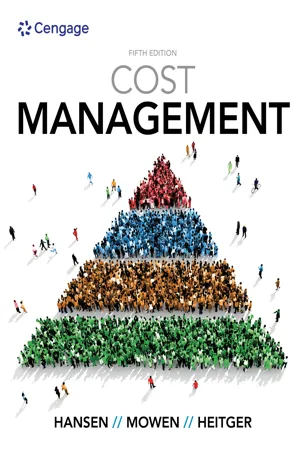Business
IRR Rule
The IRR (Internal Rate of Return) rule is a financial metric used to evaluate the profitability of potential investments. It calculates the discount rate at which the net present value of future cash flows equals zero. In essence, the IRR rule helps businesses determine the potential return on investment and compare different investment opportunities.
Written by Perlego with AI-assistance
Related key terms
1 of 5
10 Key excerpts on "IRR Rule"
- eBook - ePub
Finance
Capital Markets, Financial Management, and Investment Management
- Frank J. Fabozzi, Pamela Peterson Drake(Authors)
- 2009(Publication Date)
- Wiley(Publisher)
The index value is greater than one, which means that the investment produces more in terms of benefits than costs. An advantage of using the profitability index is that it translates the dollar amount of NPV into an indexed value, providing a measure of the benefit per dollar investment. This is helpful in ranking projects in cases in which the capital budget is limited.The decision rule for the profitability index depends on the PI relative to 1.0, which meansINTERNAL RATE OF RETURN
Suppose an investment opportunity requires an initial investment of $1 million and has expected cash inflows of $0.6 million after one year and another $0.6 million after two years. This opportunity is shown in Figure 14.3 using a time line.The return on this investment (denoted by internal rate of return or IRR, in the next equation) is the discount rate that causes the present values of the $0.6 million cash inflows to equal the present value of the $1 million cash outflow, calculated asAnother way to look at this is to consider the investment’s cash flows discounted at the IRR of 10%. The NPV of this project if the discount rate is 13.0662% (the IRR in this example), is zero:An investment’s internal rate of return is the discount rate that makes the present value of all expected future cash flows equal to zero. We can represent the IRR as the rate that solves Going back to Project X, the IRR for this project is the discount rate that solves Using a calculator or a computer, we get the answer of 10.172% per year.FIGURE 14.3Timeline of Investment OpportunityLooking back at the investment profiles of Projects X and Y, each profile crosses the horizontal axis (where NPV = 0) at the discount rate that corresponds to the investment’s IRR. This is no coincidence: by definition, the IRR is the discount rate that causes the project’s NPV to equal zero.The IRR is a yield—what is earned, on average, per year. How do you use it to decide which investment, if any, to choose? Let’s revisit Projects X and Y and the IRRs we just calculated for each. If, for similar risk investments, owners earn 10% per year, then both Projects X and Y are attractive. They both yield more than the rate owners require for the level of risk of these two investments: - eBook - PDF
- Robert Parrino, David S. Kidwell, Thomas Bates, Stuart L. Gillan(Authors)
- 2021(Publication Date)
- Wiley(Publisher)
Thus, using IRR or MIRR, rather than NPV, does not require less effort from financial managers. Summary of Internal Rate of Return (IRR) Method Decision Rule: IRR > Cost of capital ⇨ Accept the project. IRR < Cost of capital ⇨ Reject the project. Key Advantages Key Disadvantage 1. Intuitive and easy to understand. 2. Based on discounted cash flow technique. 1. With nonconventional cash flows, IRR approach can yield no usable answer or multiple answers. 2. A lower IRR can be better if a cash inflow is followed by cash outflows. 3. With mutually exclusive projects, IRR can lead to incorrect investment decisions. 4. IRR calculation assumes cash flows are reinvested at the IRR. Before You Go On 1. What is the internal rate of return (IRR) method? 2. Under what circumstances do the NPV and IRR decision rules always yield the same decision? 3. In capital budgeting, what is a conventional cash flow pattern? 4. Why should the NPV method be the primary decision tool used in making capital investment decisions? LEARNING OBJECTIVE 6. Explain how the profitability index can be used to rank projects when a firm faces capital rationing and describe the limitations that apply to the profitability index. Our discussion of capital budgeting so far has focused on determining whether an individual project creates value for stockholders. Although the analytical methods we have discussed are critical components of the capital budgeting process, they do not tell us what to do when, as is often the case, a firm does not have enough money to invest in all available positive NPV projects. In other words, they do not tell us how to identify the bundle or combination of pos- itive NPV projects that creates the greatest total value for stockholders when there are capital constraints or, as we called it earlier in this chapter, capital rationing. In an ideal world we could accept all positive NPV projects because we would be able to finance them. - eBook - PDF
Benefit-Cost Analysis
Financial and Economic Appraisal using Spreadsheets
- Harry F. Campbell, Richard P. C. Brown(Authors)
- 2003(Publication Date)
- Cambridge University Press(Publisher)
(This is discussed below.) The Internal Rate of Return (IRR) Criterion We have seen that in the case of “normal” or “well behaved” investment cash flows the NPV curve slopes downwards from left to right. At some point the curve intersects the horizontal axis. That is, it becomes “0”. The discount rate at which the NPV becomes “0” is called the Internal Rate of Return (IRR). In Example 3.5, the IRR was found to lie between 20 and 25%, approximately 23%. Once we know the IRR of an investment we can compare this with the cost of financing our project. Let us say, in this case, the cost of financing the project is 15%. Now, as the rate of return, the IRR, is greater than the cost of financing the project, we should accept the investment. In fact, in the case of this investment, we would accept the investment at any cost of finance that is below 23%. When the IRR is less than the cost of finance, the project should be rejected. We can summarize this decision-rule as: when IRR ≥ r, then accept and when IRR < r, then reject where r = the interest rate (cost of financing the project) When considering an individual project, the IRR decision-rule will always give exactly the same result as the NPV decision-rule: from the NPV curve in Figure 2.5 it can be seen that when the discount rate (cost of capital) is less than IRR, the NPV will be positive, and vice 44 Benefit-Cost Analysis versa. For instance, provided the discount rate we used to calculate the NPV (i.e. the cost of financing the project) was less than 23%, the NPV would be positive and the project accepted . Similarly, using the IRR decision-rule, we saw that once we knew what the IRR was (i.e. 23%), we would compare it with the given cost of finance, and so long as the latter was lower , we would accept the project. These two decision-rules amount to exactly the same thing in such a situation. Therefore: NPV and IRR give identical results for accept vs. reject decisions when con-sidering an individual project. - eBook - PDF
- Robert Parrino, David S. Kidwell, Thomas Bates(Authors)
- 2016(Publication Date)
- Wiley(Publisher)
WEB To read an article that warns finance managers using the IRR about the method’s pitfalls, visit www.cfo.com/ printable/article.cfm/3304945?f=options On the downside, we have seen that the IRR method has several flaws. One of these can be eliminated by using the MIRR. Nevertheless, we believe that the NPV should be the primary method used to make capital budgeting decisions. Decisions made by the NPV method are con-sistent with the goal of maximising the value of the firm’s shares, and the NPV tells management the amount by which each project is expected to increase the value of the firm. 10.6 Capital Budgeting in Practice 353 Review of Internal Rate of Return (IRR) Decision Rule: I RR Cost of capital > ➪ Accept the project. I RR Cost of capital < ➪ Reject the project. Key Advantages Key Disadvantages 1. Intuitively easy to understand. 1. With non-conventional cash flows, I RR approach can yield no usable answer or multiple answers. 2. Based on discounted cash flow technique. 2. A lower IRR can be better if a cash inflow is fol-lowed by cash outflows. 3. With mutually exclusive projects, IRR can lead to incorrect investment decisions. Before You Go On 1. What is the IRR method? 2. In capital budgeting, what is a conventional cash flow pattern? 3. Why should the NPV method be the primary decision tool used in making capital investment decisions? 10.6 Capital Budgeting in Practice Capital expenditures are major investments for firms and for economies as a whole. For the European Union in 2013, the gross capital formation for all 28 countries was €2 272 billion. Capital investments also represent large expenditures for individual firms, though the amount spent can vary widely from year to year. For example, over the last several years, the European Aeronautic Defence and Space Company N.V. - eBook - PDF
Economic Feasibility of Projects
Managerial and Engineering Practice
- S.L. Tang(Author)
- 2003(Publication Date)
- The Chinese University of Hong Kong(Publisher)
3. Discount Cash Flow Method 3.1 The Internal Rate of Return (IRR) In Chapter 2, the methods described for project appraisal were based on a predetermined discount rate i . With a predetermined i for calculating the net present worth or the net annual benefit, the result can either be positive or negative (see Examples 2.1 and 2.2 of Chapter 2). If it is positive, the project is considered viable, and vice versa. However, we might sometimes obtain, by luck, a zero result of net present worth (or net annual benefit) with the use of a predetermined i . In such a case, the project is considered breaking-even since its present worth of total benefits equals its present worth of total costs (or the total annual benefits equal the total annual costs). The discount rate i , in this case, represents exactly the rate of return on the investment over its life, and is called IRR (internal rate of return). Some people like to call it the yield rate or solution rate. Hence, IRR can be defined as the discount rate i that the net present worth of a project is zero if such i is used in the equivalence calculation. In this chapter, the reader will see a full description of the discount cash flow (DCF) method which is a method to determine the IRR of an investment, with costs and benefits known (or estimated) over the time span of the investment. Readers should note that it is not necessary for the DCF method to use a predetermined i . 3.2 Mathematical Presentation of IRR Let C k = total cash outflow (i.e. expenditure or cost) in year k , B k = total cash inflow (i.e. income or benefit) in year k , NCF k = net cash flow in year k . By definition: NCF k = B k – C k (3.1) The cash flows can be tabulated as in Table 3.1: - eBook - PDF
- Don Hansen, Maryanne Mowen, Dan Heitger, , Don Hansen, Maryanne Mowen, Dan Heitger(Authors)
- 2021(Publication Date)
- Cengage Learning EMEA(Publisher)
Since IRR . 0.10, the investment is acceptable. 3. df 5 $240,000/$102,000 5 2.353. Using Exhibit 19B.2, this discount factor now lies between 12 and 14 percent, which means the IRR . 0.10. Why: The IRR is the interest rate where NPV 5 0. The IRR is determined by solving Equation 19.2. Acceptable investments should have an IRR greater than the cost of capital (or required rate of return). The internal rate of return is the most widely used of the capital investment techniques. One reason for its popularity may be that it is a rate of return, a concept that managers are com-fortable in using. Another possibility is that managers may believe (in most cases, incorrectly) that the IRR is the true or actual compounded rate of return being earned by the initial invest-ment. Whatever the reasons for its popularity, a basic understanding of the IRR is necessary. NPV VERSUS IRR: MUTUALLY EXCLUSIVE PROJECTS Up to this point, we have focused on independent projects. Many capital investment decisions deal with mutually exclusive projects. How NPV analysis and IRR are used to choose among competing projects is an intriguing question. An even more interesting question to consider is whether NPV and IRR differ in their ability to help managers make wealth-maximizing OBJECTIVE 5 ▶ Explain why NPV is better than IRR for choosing among mutually exclusive projects. Copyright 2022 Cengage Learning. All Rights Reserved. May not be copied, scanned, or duplicated, in whole or in part. Due to electronic rights, some third party content may be suppressed from the eBook and/or eChapter(s). Editorial review has deemed that any suppressed content does not materially affect the overall learning experience. Cengage Learning reserves the right to remove additional content at any time if subsequent rights restrictions require it. Chapter 19 Capital Investment 983 decisions in the presence of competing alternatives. - eBook - PDF
- Scott Besley, Eugene Brigham, Scott Besley(Authors)
- 2021(Publication Date)
- Cengage Learning EMEA(Publisher)
Cengage Learning reserves the right to remove additional content at any time if subsequent rights restrictions require it. There exists an IRR solution for each time the direction of the cash flows associated with a project is in- terrupted, that is, each time outflows change to inflows. For example, each of the conventional cash flow patterns we depicted has only one change in the signs (direction) of the cash flows from negative (outflow) to positive (inflow); thus, there is only one IRR solution. On the other hand, each of the unconventional cash flow patterns we depicted has two interruptions, and thus two IRR solutions. Figure 9.3 illustrates the multiple-IRR problem with a strip-mining project that costs $1.6 million. The mine will produce a cash inflow of $10 million at the end of Year 1, but $10 million must be spent at the end of Year 2 to restore the land to its original condition. Two IRRs exist for this project: 25 percent and 400 percent. The NPV profile for the mine shows the project would have a positive NPV, and thus be acceptable, if the firm’s required rate of return is between 25 percent and 400 percent. 9-4 MODIFIED INTERNAL RATE OF RETURN Despite a strong academic preference for NPV, surveys in- dicate that many business executives prefer IRR. It seems that many managers find it intuitively more appealing to analyze investments in terms of percentage rates of return (IRR) rather than dollars (NPV). However, remember from our earlier discussion that the IRR method assumes the cash flows from the project are reinvested at a rate of return equal to the IRR, which we generally view as im- practical. Given this fact, can we devise a rate of return mea- sure that is better than the regular IRR? The answer is yes: We can modify the IRR and make it a better indicator of relative prof- itability, hence better for use in capital budgeting. - eBook - PDF
Profit Planning
For hospitality and tourism (extended edition)
- Peter Harris(Author)
- 2013(Publication Date)
- Goodfellow Publishers(Publisher)
This will enable us to compare the internal rate of return directly with the rate of return required by the particular business. Again, using the information in our Wellington Hotel example, we can compute the internal rate of return, shown in Figure 14.4. DCF Total DCF Total Cash factor present factor present inflow 10% value 20% value Year £ £ £ 1 10,000 0.909 9,090 0.833 8,330 2 10,000 0.826 8,260 0.694 6,940 3 10,000 0.751 7,510 0.579 5,790 4 10,000 0.683 6,830 0.482 4,820 5 10,000 0.621 6,210 0.402 4,020 Present value of inflows 37,900 29,900 Initial outlay 30,000 30,000 Net present value £ 7,900 £ (100) The IRR is calculated as follows: Differences in DCF rates 20% – 10% = 10% Difference in NPV £(100) – £7,900 = £8,000 Thus, the rate to add to 10% so that NPV = £0 is: £7,900 × 10% = 9.875% £8,000 Therefore, the IRR i.e. the true rate is 10% + 9.875% = 19.875% Figure 14.4: Internal rate of return method: Wellington Hotel The internal rate of return for the hotel project is 19.875%. In effect, this means the project would recover the full £30,000 capital outlay and, in addition, earn 9.875% interest. Note: A word of warning! Be careful not to place too much emphasis on the precise figure of a capital project return as the cash flows are only estimates which may vary substantially over the period of the project’s life; the further into the future they go the more questionable the cash flow estimates become. 212 Profit Planning Net present value versus internal rate of return Despite the difference in approach used by the net present value and the internal rate of return methods, they will both always indicate the same accept or reject position for a given project. However, in the case where two projects were being considered, but only one could be selected (mutually exclusive) the NPV and IRR rankings may differ. - eBook - ePub
Multiple Interest Rate Analysis
Theory and Applications
- M. Osborne(Author)
- 2014(Publication Date)
- Palgrave Pivot(Publisher)
et al . (2011) contains a classic statement of the arguments and lists four pitfalls.1 An IRR, by itself, does not indicate whether a project involves borrowing or lending;2 Some cash flows cause the IRR equation to solve for more than one plausible IRR, resulting in ambiguity about which IRR to use as a criterion;3 NPV and IRR do not always rank mutually exclusive projects the same; the consensus opinion is that ranking by NPV is reliable, and therefore ranking by IRR is not;4 A non-flat yield curve provides more than one cost of capital with which to compare IRR leading to uncertainty about which cost of capital to employ.Despite the pitfalls there is considerable empirical evidence that the majority of practitioners continue to use IRR as an investment criterion and performance measure. For example, in the context of capital budgeting there is the study of US data by Graham and Harvey (2001) and the similarly executed study of European data by Brounen et al . (2004). Many studies of capital budgeting practice are published every year containing similar results for various countries. In the context of IRR as a performance measure for private equity firms, hedge funds, and venture capitalists see the works by Phalippou (2008), Phalippou and Gottschalg (2009), Dichev and Yu (2011), and Achleitner et al. - eBook - PDF
ACCA Financial Management
Practice and Revision Kit
- BPP Learning Media(Author)
- 2021(Publication Date)
- BPP Learning Media(Publisher)
166 Financial Management (FM) (b) In most simple accept or reject decisions, IRR and NPV will select the same project. However, NPV has certain advantages over IRR as an investment appraisal technique. NPV and shareholder wealth The NPV of a proposed project, if calculated at an appropriate cost of capital, is equal to the increase in shareholder wealth which the project offers. In this way NPV is directly linked to the assumed financial objective of the company, the maximisation of shareholder wealth. IRR calculates the rate of return on projects, and although this can show the attractiveness of the project to shareholders, it does not measure the absolute increase in wealth which the project offers. Absolute measure NPV looks at absolute increases in wealth and thus can be used to compare projects of different sizes. IRR looks at relative rates of return and in doing so ignores the relative size of the compared investment projects. Non-conventional cash flows In situations involving multiple reversals in project cash flows, it is possible that the IRR method may produce multiple IRRs (that is, there can be more than one interest rate which would produce an NPV of zero). If decision-makers are aware of the existence of multiple IRRs, it is still possible for them to make the correct decision using IRR, but if unaware they could make the wrong decision. Mutually-exclusive projects In situations of mutually-exclusive projects, it is possible that the IRR method will (incorrectly) rank projects in a different order to the NPV method. This is due to the inbuilt reinvestment assumption of the IRR method. The IRR method assumes that any net cash inflows generated during the life of the project will be reinvested at the project's IRR. NPV on the other hand assumes a reinvestment rate equal to the cost of capital. Generally NPV's assumed reinvestment rate is more realistic and hence it ranks projects correctly.
Index pages curate the most relevant extracts from our library of academic textbooks. They’ve been created using an in-house natural language model (NLM), each adding context and meaning to key research topics.









